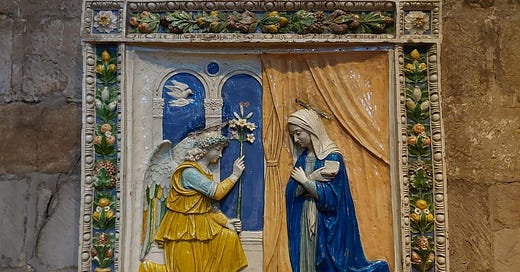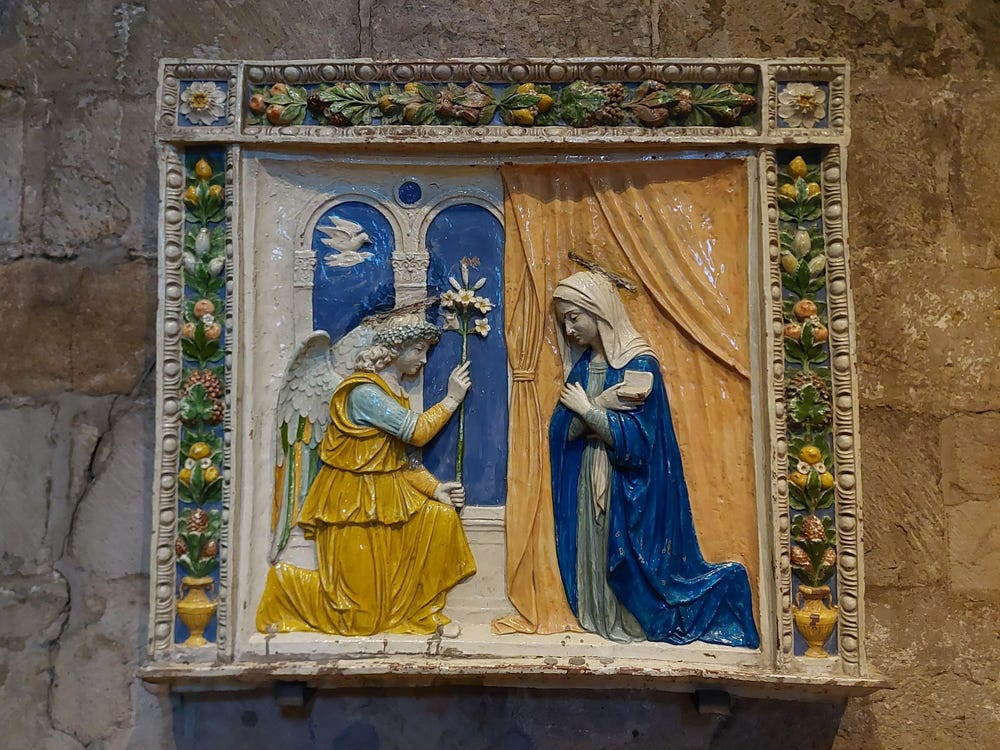A Secret in Plain Sight: Durham's Annunciation Ceramic
Historic buildings have secrets; some are hidden so well that we might call them lost, likely never to be unearthed, at least not until all is revealed ‘at the judgement seat of Christ’ (2 Cor. 5:10).
At Durham Cathedral, we ponder (for instance) the resting place of one-hundred and seven statues which once adorned our fourteenth-century reredos (i.e. the Neville Screen) between the High Altar and St Cuthbert’s Shrine at the building’s East End. These were allegedly removed by the last monastic community to protect them from the commissioners of Henry VIII (r. 1509-47). Where they were hidden, we may never know.
Then, there are secrets which have been discovered.
Such is the work of Norman Emery, Durham’s longstanding and distinguished archaeologist: to delve beneath the surface of present experience, uncovering traces of the stories of our predecessors, those with whom we stand in continuity, whose work we continue as stewards and custodians.
This post is about a third kind of secret: the secret hidden in plain sight. Durham, like most cathedrals, I suspect, has a number of these.
Visitors and pilgrims come—750,000 a year, according to one set of statistics from before the blight of the Covid-19 pandemic—and they look at the same things. From west to east: the Font, the great carved pillars, the Scott Screen (seprarating the Nave from the Choir), the Neville Screen, the High Altar, the Chapel of Nine Altars, the great rose window.
They gaze in awe at the architecture and, in the Museum, marvel at ancient artefacts. Some of the latter may once have been secrets—the pectoral cross of St Cuthbert, for example, lay dormant in his coffin from the tenth century, until being discovered among his clothes in 1827—whilst others were designed to be on public display.1 Most conceal the identity of the artist or the craftsman who made them, which is a great shame; only the fruit of their labour is there for all to gaze upon, raising minds and hearts to God.
There are, though, some things which visitors simply do not see: things they walk past, but rarely observe. By virtue of being partially concealed, small perhaps, less grand and imposing, less powerful, less well documented, and therefore less well ‘signposted’ than other fixtures, fittings and monuments, such things are simply not noticed. They are not allowed to become part of our experience of the Cathedral; we are not permitted to become their witnesses.
Just such an object may be found in the Gregory Chapel.
It’s quite possible that, even if you have visited Durham Cathedral and are familiar with the Galilee Chapel and the Chapel of Nine Altars, you may not have heard of the Gregory Chapel. It is a small but very special space in the North Transept; a beautiful place for quiet contemplation.
The object I would like to share with you may be found in this chapel. It is a ceramic plaque and its subject is none other than the Cathedral’s great patroness, the blessed Virgin Mary.
This (above) is, of course, a depiction of the annunciation: that moment when the secret and often concealed radiance of heaven broke through into Mary’s life, and Gods messenger revealed itself with the words, ‘Rejoice . . . do not be afraid; you have won God’s favour. Look! You are to conceive in your womb and bear a son, and you must name him Jesus’ (Lk 1:28, 30-31).
These words are so familiar that sometimes we fail to hear them, fail to attend to their majesty. The eternal Word of God spoke, through Gabriel, a prophetic word, to which Mary responded with her own voice, ‘let it happen to me as you have said’ (Lk 1:38).
Such faith.
Such courage.
In preparing this post, I contacted the Cathedral’s extremely knowledgable Exhibitions Officer, Marie-Thérèse Mayne, to ask about this particular annunciation scene. Her response intensified my intuition that it may be described as one of Durham’s secrets hidden in plain sight.
Marie-Thérèse explained that very little is known, except that it dates from the late-nineteenth or early-twentieth century and is in the style of a Renaissance sculptor, Andrea della Robbia (d. 1525); you can see a resemblance, I think, between our ceramic and this example of Robbia’s work in the Louvre.
Marie-Thérèse also drew my attention to a number of the work’s decorative features, based mostly upon longstanding conventions in religious art, such as the physical posture of Gabriel, gesturing to heaven, and his stem of lilies, a flower symbolising Mary’s sinlessness.
If the posture of Gabriel, the stem of lilies, and so on, may be described as the work’s ‘objective’ features, based upon a universal experience of such images, perhaps we may also look at it ‘subjectively’ or ‘contextually’, for its significance as one of Durham Cathedral’s secrets hidden in plain sight.
In my own moment of contemplation, the plaque revealed itself as a window through which something may be glimpsed of the hidden life of the Cathedral and the hidden movements of people’s hearts as they visit.
Look more closely at the heads of Mary and Gabriel; can you see the marks where two haloes used to be? Marie-Thérèse very aptly described these to me as ‘scars’.
In gazing upon and through this artwork, we recall iconoclastic moments in the Cathedral’s long history. We recall the destruction of St Cuthbert’s medieval shrine and the fragments of holy faces disfigured by hammer blows; we recall, also, the efforts of those monks to protect the statues of the Neville Screen, to which I referred earlier. Whatever caused those haloes to be removed, the glorious scars which have been left behind may be a symbol for us of a hidden history.
Now, look down at the base of the plaque.
It is difficult to detect on a flat image, but there is a narrow sill where three coins have been laid directly below the Virgin herself. These are the marks of pilgrimage; tokens left, perhaps, by a wounded heart seeking Mary’s help, or a soul uplifted giving thanks for services rendered. They are an oblation, an offering, of at least one hidden heart whose gesture stands for everyone who has ever been drawn to the Cathedral as a place of prayer.
These two features, the halo scars and the pilgrim’s coins, are a reminder that our cathedral is not an art gallery, but something more like a living thing, an organism. It has a life, a history, a story to tell; it welcomes us and bears the marks of our presence.
A secret pulsates with the meaning it conceals.
The beating heart of our image of the annunciation is not Mary, nor Gabriel, but the pregnancy of the whole event: the expectation implicit in the presentation of all the protagonists, but particularly the dove at the window, symbol of the Holy Spirit.
Patiently, respectfully, the dove waits outside Mary’s room until a word, her word, of acquiescence is given: ‘let it happen’ (Lk 1:38). The annunciation was a moment of cosmic suspension, when Gabriel's message, his question, to the maiden of Nazareth hung in the air. From eternity, Mary had been prepared for this moment by divine grace and yet, in the finite sphere of historical time, she was entirely free to choose.
Consider the magnitude of this claim: for a moment in time and according to his own design, the creator and sustainer of being, indeed Being itself, gently appealed to the good faith of a creature for assent to a divine plan. God did not ‘need’ Mary, in the sense that her cooperation was necessary to accomplish some enrichment or augmentation of divine being; rather, God sought Mary to be a special collaborator and object of his love.
In the twelfth century, the Cistercian abbot and theologian, Bernard of Clairvaux (1090-1153), took up this very theme in one of the most beautiful of his many homilies.
This is what he wrote:
Give your answer quickly, my Virgin. My lady, say this word which earth and hell and heaven itself are waiting for. The very King and Lord of all, he who has so desired your beauty, is waiting anxiously for your answer and assent, by which he proposes to save the world.2
The multivalent character of the history and witness of Durham Cathedral may well be explored in terms of the secrets it holds—some lost, others found, and many hidden in plain sight. Our contemplation of this particular depiction of the annunciation has laid before us an example of the latter.
We have been able to think about the history of the artefact, its story; to think about its witness to the history of this place, including all those whose feet have, over the centuries, worn down its stones; above all, we have been faced with an enduring symbol of the hope of our community of faith: the creature whose assent and collaboration made possible the redemption of the world.
In our own lives, perhaps we can take inspiration from this exercise, not to mention Mary’s own example, to cultivate an attentive spirit; most of all, to attend to those, the homeless, sick and imprisoned, whom others may not see.
Perhaps it could be our prayer to become ever more open to the Holy Spirit who may, just possibly, be hovering outside our window, awaiting an invitation to enter.3
On St Cuthbert’s pectoral cross, see: Sarah Foot, ‘Cuthbert and the Search for a Patron’, in David Brown, ed., Durham Cathedral: History, Fabric and Culture (New Haven, NY; London: Yale University Press, 2015), pp. 9-25 (p. 9, n. 7).
Bernard of Clairvaux, Homily IV, 8, trans. by Marie-Bernard Saïd, CF 18A (Kalamazoo, MI: Cistercian Publications, 1993), pp. 45-58 (p. 53).
This post has been adapted from a talk given to Durham Cathedral's online Community of Prayer.





